Liberals push for marginal seat shakeup at 2026 state election
The SA Liberal Party has called for the boundaries of marginal seats to be tweaked in their favour to promote a “more vibrant” state election in 2026, while Labor argues there’s no urgent need for change.

Both parties have made submissions to this year’s Electoral Districts Boundaries Commission, the independent body tasked with redrawing South Australia’s electoral map two years after every state election.
The commission’s rulings can have a significant influence on the outcome of state elections and are closely watched by Lower House MPs, whose constituencies can be dramatically altered at the stroke of a pen.
The 2018 election redraw put the Liberals in pole position for victory and prompted Labor to launch a failed Supreme Court challenge, while the 2022 carve-up saw the pendulum swing back to Labor.
This year, the Liberal Party told the commission that “in order to promote a more vibrant election… it is proposed that changes be made to several marginal districts”.
The party’s submission, written by Shadow Attorney-General Josh Teague and lawyer Thomas Duggan KC, floats changes to the boundaries of 22 of 47 Lower House seats, affecting more than 32,000 voters.
This includes several favourable changes to Labor’s marginal seats in the northeastern and southern suburbs – particularly Gibson, King, Newland, Davenport and Waite.
For example, the Liberals suggests moving nearly 1000 voters from Schubert – a blue-ribbon seat held by Liberal frontbencher Ashton Hurn – into the adjacent northeastern seat of King, one of Labor’s most marginal seats held by first-term MP Rhiannon Pearce.
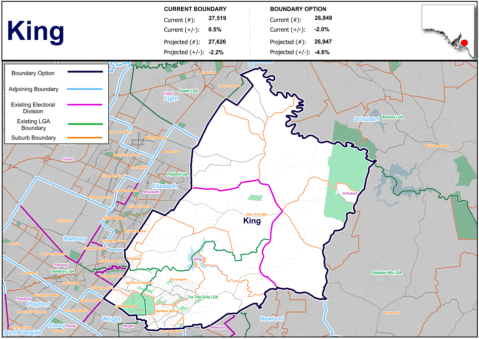
King would also lose 1600 voters from Salisbury Park, a strong Labor polling booth, to the already-safe Labor seat of Ramsay.
The Liberal Party said the changes would reduce Labor’s two-party preferred margin in King from 3 per cent to 2.2 per cent.
The Liberals also hope to shrink Labor’s margin in nearby Newland by giving it 1500 voters from Schubert and a further 800 voters from Liberal-held Morialta.
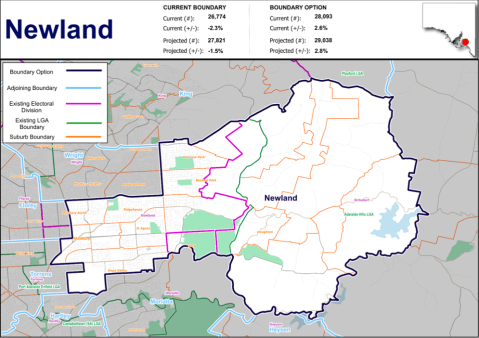
Newland, held by Labor first-termer Olivia Savvas, would also lose part of pro-Labor Modbury to the already safe Labor seat of Florey.
The changes would drop Savvas’ margin from 5.5 to 4.5 per cent, the Liberal Party estimates.
You might like
Down south, the Opposition has asked to shift roughly 2900 voters in Marion from the seat of Gibson to Elder.
Marion is a strong Labor polling booth, meaning the government’s position would be strengthened in Elder but weakened in Gibson.
“The Liberals are probably giving up on Elder and trying to give themselves the best chance of winning the surrounding seats,” said Dr Glynn Evans, visiting research fellow at the University of Adelaide and an expert in electoral boundaries and proportional representation.
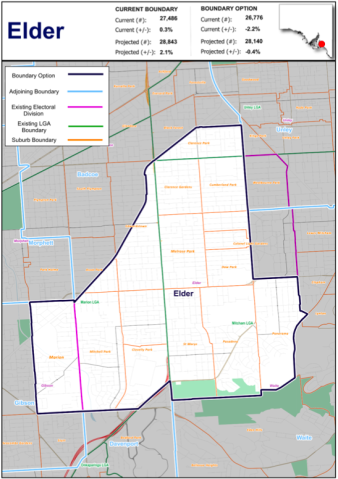
Elder has only elected a Liberal MP twice: in the landslide 1993 state bank election and the 2018 election where the Liberals benefitted from a favourable redistribution.
Evans said it was “hard to see” the Liberal Party winning back Elder from Labor’s Nadia Clancy and so it was looking to spread favourable suburbs from Elder to other marginal seats.
The party has asked the commission to move part of Colonel Light Gardens – historically a strong Liberal suburb – from Elder into Waite, which Labor holds on just 4.1 per cent.
The Liberals are also searching for a narrower margin in Davenport, suggesting it should gain the conservative areas of Cherry Gardens and Clarendon from Liberal-held Heysen.
Excluding Dunstan, which was not canvassed in the Liberal Party’s submission, Evans estimates that the proposed redistributions would make Gibson the state’s most marginal seat followed by King, Newland, Davenport and then Waite.
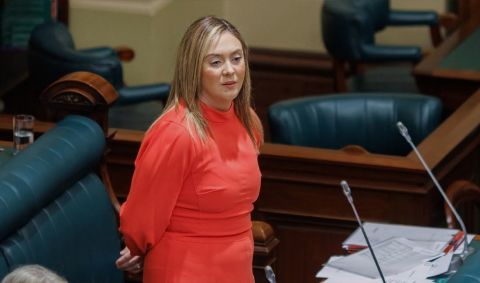
Commenting on the Liberal Party’s suggestions, Evans said: “I thought about the Rolling Stones song: ‘You can’t always get what you want, but if you try sometimes you get what you need’.
“You might not get everything you want but in asking for those changes to four or five seats, they might get something of what they want and, in the longer term, need.”
The Liberal Party may need to win six or more seats to form government in 2026 depending on negotiations with independents.
“I don’t think they’ll get what they need in terms of being in a position to win government next time, especially while (Premier Peter) Malinauskas remains popular,” Evans said.
“But if they can gain one, two or three seats this time around and win back a couple of seats from the independents, at least they’re in a position to win government at the election after next if Malinauskas starts to become a little bit unpopular.”
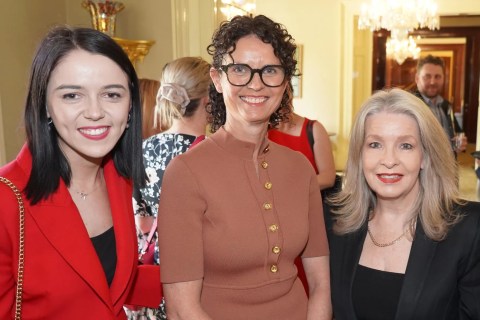
This year’s boundaries commission is chaired by Supreme Court judge Anne Bampton alongside electoral commissioner Mick Sherry and surveyor general Bradley Slape.
By law, the commission must have regard to “communities of interest”, topography, and the population of each proposed district when it is redrawing a boundary.
It can also have regard to “electoral fairness”, meaning the party which wins 50.1 per cent of the two-party preferred state-wide vote has the best chance to form government – although this requirement is no longer mandated by law after it was removed by the former Weatherill Government in 2017.
The Liberal Party submitted that its proposed changes to marginal seats are necessary because the party would only gain one seat – Gibson – if it won a 2.9 per cent swing at the next election, while the Labor Party would gain five seats on an equivalent swing (Morialta, Heysen, Unley, Black and, before the by-election, Dunstan).
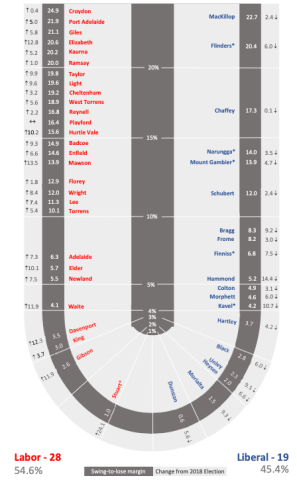
“An important principle when setting the electoral districts is to encourage a vibrant election, in the sense that seats between the major parties will change hands in response to a statewide swing,” the Liberal Party said.
Stay informed, daily
“At the moment that only occurs if there is a swing to the Labor Party.”
The Liberal Party did not propose any changes to the seat of Adelaide, which figured as a critical swing seat in 2022 and was won by Labor’s Lucy Hood.
Evans said the Liberal Party may have left Adelaide out because the only logical area for the seat to move is north into Labor-friendly Prospect.
“Any move in that direction helps Labor,” Evans said.
Labor happy with current boundaries
The Labor Party, meanwhile, has told the commission that the 2022 election boundaries “produced an appropriate result” in terms of electoral fairness and do not need to be substantially changed this year.
In its submission, the ruling party argued that the current two-party preferred pendulum is “relatively well calibrated” because the Liberal Party would win five seats on a 4.2 per cent swing.
It also said the commission is only legally required to adjust one seat – Labor’s northern suburbs stronghold of Taylor – for having too many voters.
By law, the commission is required to keep the population of each electorate within 10 per cent of a defined voter “quota”, which is this year projected to be around 28,000 electors.
The 2020 boundaries commission had to adjust six seats that were outside of the 10 per cent tolerance, with Labor arguing this year’s commission is confronted with a “less problematic” electoral map.
“It must be acknowledged that in historical terms, the 2016 redistribution and the 2020 redistribution each effected massive change to the electoral boundaries of the State, affecting hundreds of thousands of electors,” Labor submitted.
“It might be seen as desirable to make this redistribution a less significant redraw of the boundaries.”
Labor suggested moving Angle Vale from Taylor into Frome to deal with Taylor’s burgeoning voter population.
The move would shrink Liberal frontbencher Penny Pratt’s margin in Frome. Labor also suggested Frome should gain some voters from veteran Labor MP Tony Piccolo’s seat of Light.
Labor also floated the option of a more “significant change” to the boundaries involving a redraw of the state’s underpopulated rural seats to bring them closer to quota.
This would involve “reuniting” Port Augusta within one electorate by shifting eastern Port Augusta from Stuart, held by independent MP Geoff Brock, into Giles, held by Labor MP Eddie Hughes.
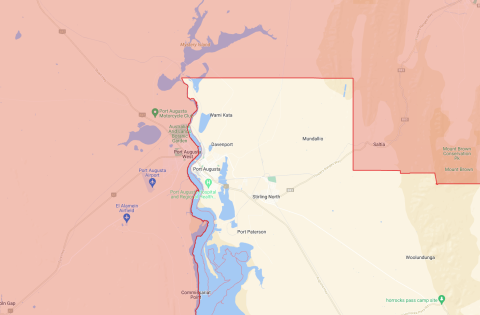
To compensate for the loss of eastern Port Augusta, Stuart would pick up voters by moving south into Frome.
Flinders, held by Liberal MP Sam Telfer, would then pick up Coober Pedy and a slew of Aboriginal communities that were previously in Giles.
The overall effect of Labor’s proposal would be to increase the population of the state’s rural seats.
University of Adelaide emeritus professor and political commentator Clement Macintyre said this would mean more Liberal voters being “locked up” in safe Liberal seats, increasing Labor’s competitiveness in metropolitan Adelaide.
“Labor for its part are quite happy with the results that came in from the 2022 election,” he said.
“They’re arguing that we shouldn’t make major changes and that if the commission wants to make a change then it recognises that the population patterns are such that the urban seats will continue to grow faster than the regional seats.
“And therefore, what the commission should be doing is pumping a few more people into those regional seats to minimise the need for substantial change in subsequent years.”
Macintyre said both the Labor and Liberal Party submissions were “par for the course” compared to previous years.
“Both of those political parties are making submissions conscious that they are… wanting to advantage their own position as much as possible,” he said.
“Both of them are putting in I don’t think outrageous I think quite well-considered submissions recognising the sorts of arguments that are likely to influence the commission and tailoring them in such a way that they benefit the party making the case.”
The commission will release its draft boundaries on August 15 before making its final determination in November.








